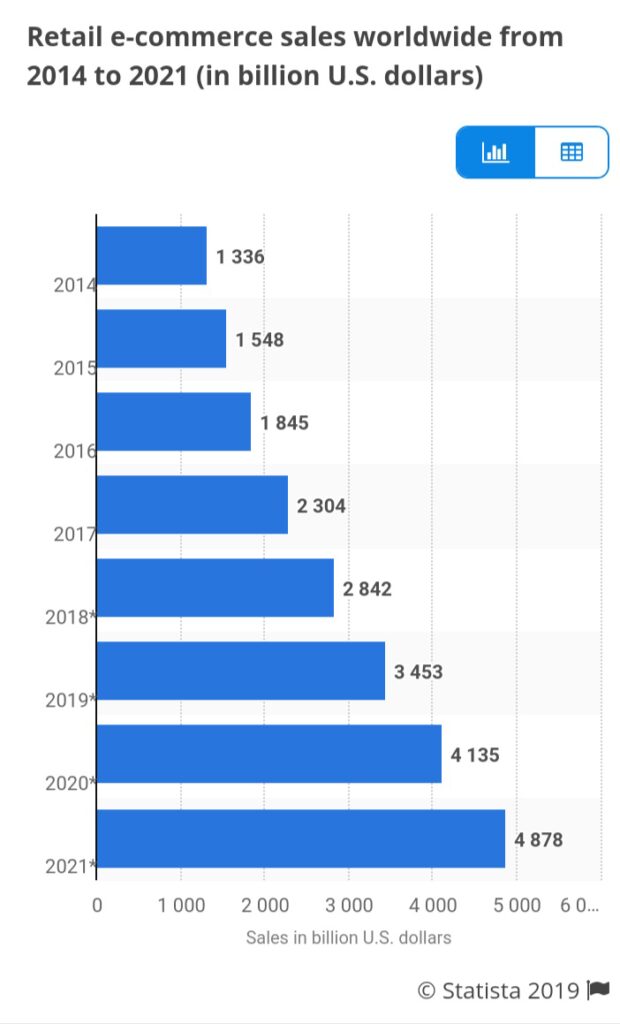
Still wondering why, how or when you should start dropshipping? Truth is, like Michael Jackson said, you’re not alone. There are many search queries from people who also want to learn how to start a dropshipping business.
In fact, some entrepreneurs spend hundreds and thousands of dollars on different eCommerce or mini importation courses and yet for some reason, never really get to start.
If you’re one of those who need extra motivation to start a dropshipping business then I have good news. In this post we’ll be highlighting five (5) eCommerce statistics showing why you should become a dropshipper, but before that
What is Dropshipping?
Normally, to start a physical retail business e.g. supermarket, you’ll probably need:
- a store
- warehouse
- goods
- display shelves
- staff
- security cameras
- PCs
- POS machines, to name a few
With dropshipping, you don’t need all of these to start or run your own retail business. With a website and requisite knowledge of how this business works you too can become a dropshipper in a matter of days. For more details check www.oberlo.com
As you can see it costs far less to start a dropshipping business than a physical retail store or supermarket. With less than $50 you can be up and running. This low entry barrier is one of the biggest reasons to start this business.
Since numbers don’t lie, the following are facts and eCommerce statistics showing why now is a good time to start this unique business
Statistics Speak
1. Global eCommerce Revenue
The world has become a global village with an emerging online marketplace, the internet. So big is this market that as far back as 2014 global eCommerce alone generated over $1.34 trillion in revenue.
Four years later in 2018, this figure more than doubled to $2.84 trillion in eCommerce revenue. One year down the line, global eCommerce revenue is projected to reach $3.45 trillion.
The following table helps put things in perspective, it shows global eCommerce revenue projections from 2014 to 2024.

2. Number of Digital Buyers
As can be seen above, global eCommerce revenue is nearing the $5 trillion mark. Buyers like you and I make this possible. Every time we purchase products or services online, we’re contributing to eCommerce growth.
Reports suggest that as of 2016 there were over 1.52 billion digital buyers. Come 2024, there’d be over 2.14 billion digital buyers contributing over $4.88 trillion to the economy.
With increasing internet access more and more buyers are going digital, spending more and more online. If you start today, some of these digital buyers may soon be buying from you.

3. Cross Border Market
Speaking of global eCommerce and digital buyers, one thing is key; borderless commerce or cross border commerce as some call it. These two forces make it possible to be in Hong Kong and buy products from US all from your smartphone, tablet or PC.
This comes with some perks like global recognition, foreign exchange, playing in new and emerging markets, etc.
Also encouraging is the number of digital buyers who have bought things from countries other than their countries of residence as seen below:

4. Top Retailers Going Online
According to Matt Kleinschmit, you either “go online or go home”. This makes perfect sense considering changing consumer behavior patterns which increasingly favor online shopping. Recently Lazada acquired Red Mart and took it online.
Factors like convenience, competitive pricing, same day or two-day delivery, etc. are encouraging buyers to shop more online. For retailers, factors like zero stock/inventory, automation, zero theft/shoplifting, global market, etc., make online commerce attractive.
Marks & Spencer plans to spend £350 million between 2016 and 2024 to strengthen its online presence. John Lewis saw over 40% of sales come from online and planned to spend more in online marketing. Next said it would spend £10 million to boost its online marketing efforts. If these big players are going online there’s definitely something big in eCommerce for you too.
5. Dropshipping By the Numbers
Although there aren’t sufficient data yet for dropshipping, the following stats still hold up. As of 2016, around 23% of online sales were fulfilled by dropshipping. Around 33% of retailers operate a dropshipping model.
As far back as 2011, dropshipping accounted for 34% of sales on Amazon. These are statistics that shed light on how this unique online business is evolving and gaining more grounds.
Shopify alone powers over 700 thousand stores all of them dropshippers. These numbers point in one direction, that dropshipping may be the way to go and now is a great time to start.
Conclusion
Now is always the best time to start anything, and with the eCommerce statistics and figures highlighted above, you have more reasons to start dropshipping now.














